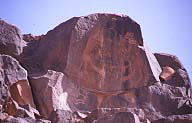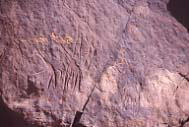
In 1951s, Italian and Libyan archaeologists went to the dried-up vally
in th Tassili-n-Ajjer ranges and the Tadrart-Acacus rages and there they
discouvered the picture rocks. These petoglyphs reveal that during wetter
and more humid times, animals such as giraffes and elephants roamed the
Sahara. After analysing over 300 petroglyphs, it was proved that they were
drawn between 12,000 B.C. and 50 B.C.
Archaeologists divided thses petroglyphs into four periods.
1) the period of wild animal; elephants, rhinoceri, giraffes...
12,000 B.C. - 8,000 B.C. The Sahara in this era was grassy
savanna.
2) the period of hunting people
7,000 B.C. - 4,000 B.C. During this period, many petroglyphs
of hunting scene in red and yellow colour
were discovered.
3) the period of cattle breeding
4,000 B.C. - 500 B.C. Since this period, the climate has become dry. The fauna in savanna has
disappeared and then
cows were drawn as a picture rock.
4) the period of hourses
500 B.C. - 200 B.C.
After (4), the period of camels continued. Around 200 B.C. camels were
brought in Egypt from Persia and then
propagated in the Sahara. By this transition of petroglyphs, we can see
how this region has changed and also how
people have lived in such a severe environment.
BACK


